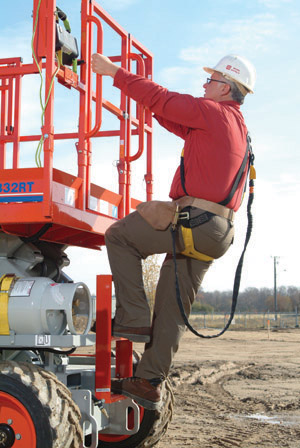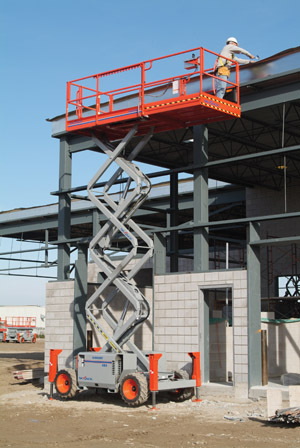
elevating work platforms:Familiarization or training
By Canadian Rental Service
Features Tech tipsIn 1999, the ANSI A92.6 standard introduced a definition for familiarization that clearly differentiated this activity from training. “Training” consists of the instructions necessary to enable a trainee to become a qualified person regarding the task to be performed, including the recognition of potential hazards.
 |
| “Training” consists of the instructions necessary to enable a trainee to become a qualified operator. |
 |
| “Familiarization” is the information regarding the control functions and safety devices on a specific aerial platform.
|
The distinction between training and familiarization does not appear to be fully understood
In 1999, the ANSI A92.6 standard introduced a definition for familiarization that clearly differentiated this activity from training. “Training” consists of the instructions necessary to enable a trainee to become a qualified person regarding the task to be performed, including the recognition of potential hazards. “Familiarization” is the information regarding the control functions and safety devices on a specific aerial platform to be operated by a qualified person or a trained operator.
In 2006, many of the aerial lift standards were updated to consistently incorporate this language. The definition for familiarization was revised to add that the information regarding the control functions and safety devices is to be given directly to a qualified person or the operator who will control the movement of the aerial platform. Yet, even with these clarifications, the distinction between training and familiarization does not appear to be fully understood. Too often familiarization upon delivery is being accepted as operator training.
Operator training addresses the safe use, general operating practices and
recognition of hazards when covering a category of aerial platforms like self-propelled elevating work platforms or boom-supported elevating work platforms. It only addresses the control functions and safety devices of the specific machine being utilized in the training class. This is why instruction on the control functions and safety devices of a specific machine must be given during familiarization and is required in addition to operator training prior to operating an aerial device. There are many different controls and safety devices on the wide variety of model aerial platforms that a trained operator must be made aware of to ensure safe use.
The major difference between training and familiarization is the scope and extent of material covered. For instance, when you offer operator training on scissor lifts, do you review every machine on the market? The answer is no, it is not possible to train for every model. One manufacturer alone has at least 14
different models of self-propelled elevating work platforms such as drivable scissor lifts or vertical lifts. These machines are available in heights from 10 feet to in excess of 50 feet. They have a variety of power sources including electric, gas, LP or diesel. They feature gradability from zero to 45 per cent and are available with every conceivable option. It would be impossible to cover all the different controls and safety devices during training. This is why unit specific familiarization is needed.
Familiarization is to be given to individuals who are qualified. In other words, you must be trained before you can be familiarized. Familiarization provides limited information.
It identifies the weather resistant compartment (for manual storage), confirms the required manuals are in place, reviews control functions and reviews safety devices on the lift being provided.
Familiarization generally takes place at the point of delivery of the machine and takes about 15 minutes. The dealer or rental company has the responsibility to provide familiarization to the person designated by the receiving party. The receiving party is generally the entity who will be directing their employees to operate the aerial lift. They must ensure operators are properly trained, familiarized and made aware of the requirements of an operator as defined by ANSI prior to authorizing them to operate an aerial lift. It is important that the receiving party designate, the machine operator or another qualified (trained) person to receive the familiarization prior to operating the machine and be responsible for familiarizing any other person authorized to operate the lift.
The following example will illustrate the necessity to both properly train and familiarize the operator of an aerial platform. An employer had an individual that was properly trained to operate scissor lifts. When he was trained, however, he utilized a 19-foot electric scissor during the instructions. On a particular project, the work required a 50-foot internal combustion engine scissor lift. For whatever reason, the operator was not familiarized with the machine when it was delivered and he did not know the machine was equipped with a safety device that prevented the lift from being driven when the platform was elevated above 25 feet. The lift would be unstable above that height, if driven.
The operator started working at lower elevations and was able to drive the lift without any problem since the platform was raised less than 25 feet. As the job progressed his working height exceeded 25 feet and the lift would no longer drive.
The operator believed the machine had mechanical problems and requested an electrician on site look at the machine. The electrician was not properly trained to inspect and service the equipment. He examined the machine and put a ‘jumper wire’ over the limit switch (the safety device) that prevented the lift from driving
if elevated over the 25-foot height.
The operator believed the lift was fixed and continued with his work. His work progressed at 32 feet and since the safety device was compromised, he was able to drive in the elevated position without a perceived problem. When one part of his job required him to work at 50 feet, the operator tried to drive the lift and it tipped over.
One could technically argue that if this person had been properly trained, he or she would have familiarized themselves on the machine with the aid of the manufacturer’s manual. A qualified operator would also not have allowed an untrained person to service the equipment. There are other points that could be drawn, but the intent of the example is to highlight the necessity and value of providing familiarization on a specific machine in addition to operator training.
While aerial work platforms are inherently safe to use, advances in machine design and built-in safety features can only be fully realized by competent users and qualified operators. One needs to assess the job to be performed, choose the proper lift for the job, and have it operated by a trained, qualified operator who is familiarized with the machine prior to operation. Operator training and familiarization provide a powerful one-two punch to knock out accidents on your job site.
The AWPT has published a technical guide on familiarization to assist in the understanding of the requirement for aerial lift operators to receive both proper training and familiarization before being authorized to operate an aerial lift. Titled “Technical Guidance – Familiarization” the document is available online and may be downloaded free of charge at www.awpt.org.
Aerial Work Platform Training Inc. (AWPT), the North American subsidiary of the International Powered Access Federation (IPAF) offers approved training centres to provide operator training that meets ANSI and OSHA requirements. Training can be completed in one or two days, depending on the machine categories. Courses combine theory and practice, with a written and a practical test. Successful trainees receive the PAL Card (Powered Access Licensed-Registration) as proof of training.
Print this page